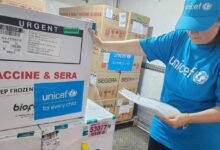UN and partners report acute malnutrition surge in Government-controlled areas of Yemen
 Acute malnutrition is escalating among children in Government-controlled areas in Yemen, UN agencies and partners said in a report published on Sunday.
Acute malnutrition is escalating among children in Government-controlled areas in Yemen, UN agencies and partners said in a report published on Sunday.
The sharp increase is being driven by diseases, including cholera and malaria, high food insecurity, and limited access to safe drinking water and other essential services, according to the analysis by the Integrated Food Security Phase Classification (IPC) Technical Working Group.
Yemen has been mired in conflict and economic collapse for nearly a decade. As Government forces, backed by a Saudi-led coalition, and Houthi rebels, continue to battle, more than 18 million people, over half the population, require humanitarian aid to survive.
Tweet URL
Young children going hungry
The report covers the period from November 2023 to October 2024.
It found that the number of children under five in Government-controlled areas who are suffering from acute malnutrition rose by 34 per cent compared to last year.
Overall, some 600,000 boys and girls are affected, including 120,000 who are severely malnourished. Additionally, around 223,000 pregnant and lactating women in these areas were found to be acutely malnourished.
For the first time, the most severe level of malnutrition – extremely critical acute malnutrition – was reported in two districts in the southern lowlands of Hudaydah governorate (Al Khawkhah and Hays), and another in Taiz (Al Makha).
The report noted that Mawza district in the Taiz lowlands is also projected to join them.
“These districts require immediate intervention to prevent increased morbidity and potential mortality among children under five years of age,” the experts said.
Lean season fears
Hudaydah and Taiz had already been facing the highest rate of stunting, or chronic malnutrition, the report noted, indicating that repeated deprivations are also aggravating chronic malnutrition among children there.
Furthermore, the prevalence of acute malnutrition in Hudaydah soared to 33.9 per cent from 25.9 per cent year on year.
The report anticipates that all 117 districts in Government-controlled areas surveyed, all located in the south, will experience “serious” levels of malnutrition or worse during the lean season from July to October.
Investment and support
“To protect the most vulnerable women, girls and boys, an investment in and scale-up of prevention and treatment efforts are more critical than ever,” said Peter Hawkins, the UN Children’s Fund (UNICEF) Representative to Yemen.
UNICEF, together with sister UN agencies the World Food Programme (WFP), the Food and Agriculture Organization (FAO) and the World Health Organization (WHO), are calling for urgent support and action to address the root causes of acute malnutrition in Yemen by strengthening existing social protection, health, food and water, sanitation, and hygiene systems.
At the same time, they stressed that ending the nearly decade-long conflict and restoring peace are critical to both address challenges and build the resilience of Yemen’s people, who have been devastated by the lack of basic services, repeated displacements, and shattered economic and social systems.
‘A wakeup call’
Dr. Hussein Gadain, FAO Representative in Yemen, reaffirmed commitment to supporting “the sustainable restoration and diversification of agricultural livelihoods to help address the urgent needs.”
Meanwhile, WFP is currently forced to provide smaller rations in Yemen, and the report’s findings “should be a wakeup call that lives are at stake,” said Pierre Honnorat, the agency’s Representative and Country Director.
“It is critical to step up support to the most vulnerable who could sink deeper into food insecurity and malnutrition if current low levels of humanitarian funding persist,” he added.
Dr. Arturo Pesigan, WHO Representative to Yemen, said the rising level of acute malnutrition in Yemen’s under-fives also indicates that diseases are of concern.
He stressed that addressing health and nutrition emergencies requires “integrated health and nutrition services, including childhood illness management”, as well as ensuring up-to-date immunization and appropriate feeding practices.
“This is in addition to ensuring access to sufficient nutritious food and safe drinking water,” he said. “Humanitarian actors and the international community must take immediate action to safeguard the future of Yemen’s children.”



